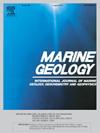由水下固定平台破坏引发的海岸后退溃决破坏发现
IF 2.2
3区 地球科学
Q2 GEOSCIENCES, MULTIDISCIPLINARY
引用次数: 0
摘要
后退溃决破坏(RBF)是一种海底滑坡,它会在水面上下形成几乎垂直的沙墙。先前的研究认为rbf的机制有四个阶段,包括触发、传播、终止和恢复阶段。对后三个阶段进行了实验室和实地研究,但由于事件的发生在空间和时间上都是不可预测的,因此rbf的触发机制仍然未知。位于澳大利亚布里斯班东北37公里的North Stradbroke Island上的Amity Point是一个有价值的海岸流滑研究地点,大约每两周发生一次(Beinssen et al., 2014)。为了揭示水流滑坡的触发机制,我们制造了一个8米高的水下三脚架,并锚定在海床上。参考现有研究(Beinssen et al., 2014),三脚架的位置被设计为固定在1.5米至2米深的螺旋锚点上,在水流滑动事件中水深变化最小。由于三个螺旋锚中的两个(包括2米深的锚)被明显的水下水流滑动破坏,三脚架在一夜之间坍塌,而海滩上只有最小的水流滑动证据。三脚架的短寿命表现出rbf的复杂性(特别是水下)和现有研究的局限性。没有传播到海岸(或轻微侵蚀海岸)的水下RBF事件比以前的研究报告发生得更频繁(Beinssen et al., 2014)。虽然它没有传播到海岸,但这一事件仍然侵蚀了水下大量的沙子。它表明触发发生在水下10米甚至更深的地方。本文章由计算机程序翻译,如有差异,请以英文原文为准。
Discoveries on coastal retrogressive breach failures inspired by failure of an underwater fixed platform
Retrogressive breach failures (RBF) are submarine landslides that result in a nearly vertical sand wall above and below the water surface. Previous studies suggest a four-phase mechanism of RBFs, including triggering, propagation, termination, and recovery phases. There have been both laboratory and field studies on the later three phases, while the triggering mechanism of RBFs remain unknown given the event occurrence is unpredictable both spatially and temporally.
Amity Point on North Stradbroke Island, 37 km Northeast from Brisbane, Australia is a valuable coastal flow slide study site with frequent occurrence of approximately every two weeks (Beinssen et al., 2014) of them at a fixed location. Aiming at revealing the triggering mechanism of flow slides, an eight-meter-tall underwater tripod was manufactured and anchored on the seabed. The tripod location was designed to be fixed at a point with minimum bathymetry change during flow slide events referring to existing studies (Beinssen et al., 2014) with between 1.5 m and 2 m deep helical anchors. The tripod collapsed overnight by the undermining of two of the three helical anchors, including the 2 m deep anchor, by a significant underwater flow slide while there was minimal flow slide evidence on the beach.
The short lifespan of the tripod presents the complexity of RBFs (especially underwater) and the limitations of existing research. Underwater RBF events that do not propagate to the shore (or slightly erode the shore) occur more frequently than previous research reported (Beinssen et al., 2014). While it does not propagate to the shore, the event still erodes a significant amount of sand underwater. It indicates the triggering occurs at 10 m underwater or even deeper.
求助全文
通过发布文献求助,成功后即可免费获取论文全文。
去求助
来源期刊

Marine Geology
地学-地球科学综合
CiteScore
6.10
自引率
6.90%
发文量
175
审稿时长
21.9 weeks
期刊介绍:
Marine Geology is the premier international journal on marine geological processes in the broadest sense. We seek papers that are comprehensive, interdisciplinary and synthetic that will be lasting contributions to the field. Although most papers are based on regional studies, they must demonstrate new findings of international significance. We accept papers on subjects as diverse as seafloor hydrothermal systems, beach dynamics, early diagenesis, microbiological studies in sediments, palaeoclimate studies and geophysical studies of the seabed. We encourage papers that address emerging new fields, for example the influence of anthropogenic processes on coastal/marine geology and coastal/marine geoarchaeology. We insist that the papers are concerned with the marine realm and that they deal with geology: with rocks, sediments, and physical and chemical processes affecting them. Papers should address scientific hypotheses: highly descriptive data compilations or papers that deal only with marine management and risk assessment should be submitted to other journals. Papers on laboratory or modelling studies must demonstrate direct relevance to marine processes or deposits. The primary criteria for acceptance of papers is that the science is of high quality, novel, significant, and of broad international interest.
 求助内容:
求助内容: 应助结果提醒方式:
应助结果提醒方式:


